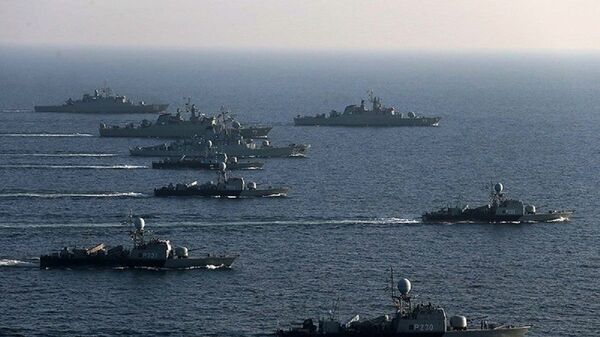A senior US Navy official in the Middle East on Sunday applauded the fact that America had reached an “uneasy deterrence” with Iran after months of escalating tensions, reported AP.
Special thanks to the Kingdom of #Bahrain for hosting us at the #Manama_dialogue today #IISSMD20 with the @IISS_org, to offer some thoughts on promoting dialogue and social justice in order for lasting security in the Middle East. pic.twitter.com/VW4jHwHRXP
— Badr Albusaidi - بدر البوسعيدي (@badralbusaidi) December 5, 2020
Vice-Admiral Sam Paparo, who oversees the Navy’s 5th Fleet based in Bahrain, while delivering comments to the annual Manama Dialogue hosted by the International Institute for Strategic Studies, spoke of having a “healthy respect” for both Iran’s regular navy and the naval forces of the Islamic Revolutionary Guard Corps (IRGC). The latter has been blacklisted by the United States as a terror group.
“We have achieved an uneasy deterrence. That uneasy deterrence is exacerbated by world events and by events along the way. But I have found Iranian activity at sea to be cautious and circumspect and respectful, to not risk unnecessary miscalculation or escalation at sea,” said the Vice-Admiral.
Vice Adm. Sam Paparo, who oversees the Navy's 5th Fleet based in Bahrain, described having a "healthy respect" for both Iran's regular navy and the naval forces of its paramilitary Revolutionary Guard.#Iran #USNavy #centcomhttps://t.co/60DIayDpWp
— IATLA (@IATLAnet) December 6, 2020
The several months that Paparo has been in charge have not seen any major crises with Iran, despite the US Navy routinely registering encounters with the Islamic Revolutionary Guard Corps (IRGC), whose speedboats patrol shallower waters of the Persian Gulf and the Strait of Hormuz.
Nevertheless, Paparo was cited as quoting former US Defence Secretary Jim Mattis at one point:
“Be polite, be professional and have a plan to kill everyone in the room… That’s how we conduct ourselves at sea.”
There has not been any official comment on the remarks from Iran’s mission to the United Nations.
‘Reckless and Provocative’
The statements by the former Navy fighter pilot who previously served as director of operations at the US military’s Central Command were in stark contrast to those recently made by his predecessor, Vice-Admiral James Malloy.
Vice. Adm. James Malloy Nominated to Lead 5th Fleet Following Death of Former Commander - USNI Newshttps://t.co/rcrIQDMI3v pic.twitter.com/iNyjKvcE2S
— U.S. Naval Institute (@NavalInstitute) December 6, 2018
In August, Malloy slammed Iran as “reckless and provocative”, whose dramatic naval drills seek to “lower the denominator until they’re sure that they can look like they’ve won something.”
As Malloy prepared to turn command over to Vice-Admiral Samuel Paparo, he denounced what he called Iran’s “aggressive harassing activities, attacks and seizures of ships, and unsafe and unprofessional encounters”.
In October, the top US admiral in the Middle East told Reuters that Iran had failed to scale back military posturing in the region after the 14 September 2019 attacks on a pair of Saudi Aramco oil-processing facilities in Abqaiq and Khurais.
Although Yemen’s Houthi militia formally claimed responsibility for the drone strikes, vowing more attacks unless Saudi Arabia and its allies halted its five-year campaign in Yemen to restore ousted President Abdrabbuh Mansur Hadi to power, Riyadh and its allies pointed the finger of blame at Iran.
Tehran has denied all allegations.
Malloy’s tenure was also marred by a spate of oil tanker seizures in the Persian Gulf in May-July 2019. British commandos seized a supertanker carrying Iranian oil off Gibraltar, with Iran intercepting a British-owned tanker two weeks later. Both ships were eventually released, yet in response, the United States announced deployment of 1,000 additional troops to the Middle East.

In June 2019 Iranian forces shot down a US spy drone they claimed had breached Iranian airspace, despite the Pentagon insisting it was in international territory over the Strait of Hormuz. The incident brought relations to the brink as President Donald Trump ordered a retaliatory strike against Iran, which was cancelled at the last minute.
At the start of 2020 US-Iran tensions escalated as the Islamic Republic’s most powerful military commander Qasem Soleimani was killed in a US drone strike in Baghdad.
All the incidents fed into bellicose rhetoric between the sides that began with Trump’s withdrawal from the 2015 Joint Comprehensive Plan of Action (JCPOA), or Iran Nuclear Deal, after Washington claimed that Tehran was in violation of its terms.
Ever since, the US had been raising sanctions against Iran, as part of its “maximum pressure campaign”.


